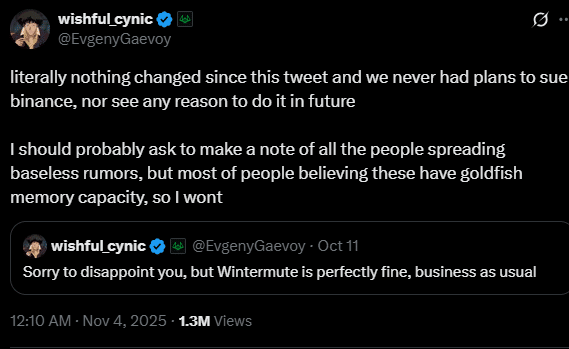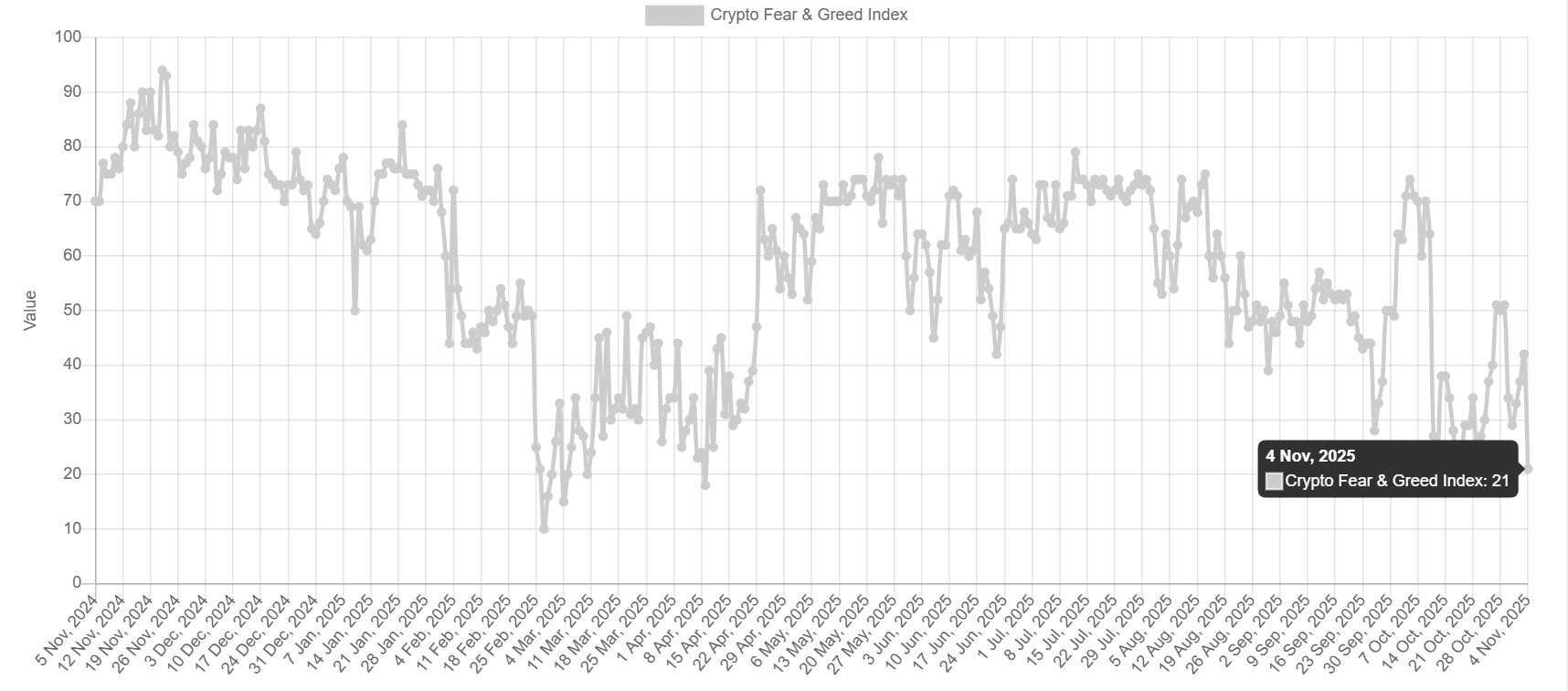Wintermute has firmly denied rumors of suing Binance over the October 10, 2025 flash crash, with CEO Evgeny Gaevoy confirming the firm remains solvent and sees no basis for legal action against the exchange.
-
Flash crash impact: The October 10 event led to significant market turmoil, with depegging on Binance contributing to billions in losses.
-
Rumors originated from pseudonymous social media posts claiming Wintermute suffered hundreds of millions in damages.
-
Binance repaid over $700 million to affected users, sparking debates on accountability despite the exchange attributing the crash to external macro factors like U.S.-China tariffs.
Explore Wintermute’s denial of Binance lawsuit rumors amid the 2025 flash crash fallout. Uncover facts on market transparency and crypto stability—stay informed on key developments today.
What are the Wintermute Binance lawsuit rumors?
Wintermute Binance lawsuit rumors stem from the chaotic October 10, 2025 flash crash that rocked cryptocurrency markets, leading to speculation about legal repercussions. Market maker Wintermute, a key player in providing liquidity, was rumored to have incurred massive losses due to depegging events on the Binance exchange. However, Wintermute’s CEO, Evgeny Gaevoy, publicly refuted these claims, emphasizing the firm’s financial stability and lack of intent to pursue litigation. This denial highlights ongoing tensions in the crypto space regarding accountability during market disruptions.
Why did the flash crash spark these Wintermute Binance lawsuit rumors?
The flash crash on October 10, 2025, triggered a rapid depegging of stablecoins and other assets on Binance, resulting in an estimated $2 billion in temporary losses across the ecosystem. According to reports from blockchain analytics firms like Chainalysis, such events often expose vulnerabilities in liquidity provision, where market makers like Wintermute play a critical role in stabilizing prices. The rumors gained traction when a pseudonymous X user known as Whale Pump alleged that Wintermute had lost hundreds of millions and was rallying other market participants for a class-action suit against Binance. Gaevoy countered this in a detailed X post, stating outright that no such plans existed and that the firm had weathered the storm without insolvency. Experts from the Crypto Council for Innovation have noted that these incidents underscore the need for robust risk management protocols, with historical data showing similar crashes, like the 2022 Terra collapse, leading to regulatory scrutiny but rarely immediate lawsuits. Arthur Cheung, CEO of DeFiance Capital, echoed this sentiment, warning that without greater disclosure from exchanges, user trust could erode further. Binance, for its part, attributed the crash to external pressures, including escalating U.S.-China tariff disputes that rattled global markets. In response, the exchange issued over $700 million in reimbursements to impacted users, a move praised by some for protecting retail investors but criticized by others as an implicit admission of fault. This controversy has fueled broader discussions on whether crypto platforms should adhere to traditional financial standards of care, with ongoing analyses from Deloitte indicating that 70% of market participants now demand enhanced transparency to prevent future volatility spikes.

Source: X
Gaevoy’s statement extended beyond denial, addressing misinformation directly: “We never had plans to sue Binance, nor see any reason to do it in the future.” He also clarified that Wintermute had not approached other entities to build a case, countering narratives of coordinated action among liquidity providers.
Frequently Asked Questions
Is Wintermute actually planning to sue Binance after the 2025 flash crash?
Wintermute has explicitly denied any intentions to sue Binance over the October 10, 2025 flash crash. CEO Evgeny Gaevoy stated on X that the firm is fully solvent, did not suffer a blow-up, and finds no grounds for litigation, dismissing the rumors as unfounded FUD spread during market anxiety.
What caused the October 10 flash crash on Binance?
The October 10, 2025 flash crash on Binance was primarily triggered by a depegging of stablecoins amid broader market pressures, including U.S.-China tariff escalations. Binance described it as an internal glitch exacerbated by macroeconomic factors, leading to rapid liquidations and temporary losses estimated in the billions before stabilization efforts kicked in.
Key Takeaways
- Wintermute’s Firm Denial: The market maker has categorically rejected lawsuit rumors against Binance, affirming its solvency post the October 2025 flash crash and urging the community to avoid speculative FUD.
- Binance’s Response Measures: By reimbursing over $700 million to users, Binance demonstrated a commitment to user protection, though this action has intensified debates on exchange liability in volatile crypto environments.
- Push for Greater Transparency: Industry leaders like DeFiance Capital’s CEO are advocating for clearer accountability standards, positioning the event as a potential landmark for crypto regulation akin to traditional finance.
CZ shrugs off the lawsuit claims
Binance’s founder, Changpeng Zhao (CZ), addressed the swirling rumors with characteristic brevity, labeling them as fear, uncertainty, and doubt (FUD) tactics amid a jittery market. In posts on X, CZ explained that the crash stemmed from an internal processing issue compounded by global economic news, such as the renewed U.S.-China tariff tensions in early 2025. He defended the repayment initiative, noting it was designed to safeguard users regardless of fault, countering critics who questioned the exchange’s motives with, “If you didn’t do it, why repay?” CZ further observed that market participants, feeling the pain of losses, often amplify negative narratives, allowing opportunistic actors to profit from the ensuing panic. This perspective aligns with analyses from PwC, which highlight how social media can accelerate misinformation in decentralized markets, with studies showing a 40% spike in FUD-related trading volume during similar events.
The initial spark for the Wintermute Binance lawsuit rumors came from Whale Pump’s X thread, where the anonymous poster claimed insider knowledge of Wintermute’s damages and impending legal moves. “Wintermute is suing Binance. And they are not the only ones that got rekt…I have all the names of who is about to blow up. It’s not going to be pretty,” the post read, igniting widespread speculation. CZ’s retort emphasized resilience: “Lots of random FUD in the market. People are in pain, jittery, and anxious. Whales are pouncing on it, spreading more FUD, and cashing in on it.” This exchange underscores the high-stakes environment of crypto trading, where liquidity providers like Wintermute absorb shocks to maintain order books, often at significant risk.
Calls for transparency rise
Post-crash, voices from the investment community have grown louder, demanding that Binance and similar platforms reveal more about incident root causes and accept potential liability. Arthur Cheung of DeFiance Capital articulated this in a statement, viewing the episode as a pivotal test for the industry: “The October 10 case could become a landmark test of whether crypto exchanges owe a duty of care comparable to traditional markets. Users shouldn’t assume they’re powerless—legal and reputational dynamics can shift quickly once facts come to light.” This call resonates with findings from the Financial Stability Board, which in its 2025 crypto report recommended standardized disclosure rules to mitigate systemic risks, citing data that exchange transparency correlates with 25% lower volatility in stressed conditions.
Wintermute’s role in the ecosystem involves algorithmic trading and liquidity across major venues, including Binance, where it facilitates seamless order execution. The flash crash exposed how interconnected these operations are, with depegging events cascading through perpetual futures and spot markets. While Binance’s reimbursements provided immediate relief, they did little to quell underlying concerns about operational resilience. Market data from Kaiko Analytics post-event showed a 15% dip in trading volumes on Binance, reflecting eroded confidence that has since partially recovered amid stabilizing global sentiment.

Source: Alternative Me
Conclusion
The Wintermute Binance lawsuit rumors illustrate the fragility of trust in cryptocurrency markets, particularly following the disruptive October 10, 2025 flash crash driven by depegging and macro pressures. With Wintermute affirming its stability and Binance prioritizing user reimbursements, the focus shifts to enhancing transparency—a二次 keyword essential for long-term sector maturity. As experts like Arthur Cheung advocate for duty-of-care standards, the industry stands at a crossroads, poised for regulatory evolution that could fortify resilience against future shocks and foster sustainable growth.
